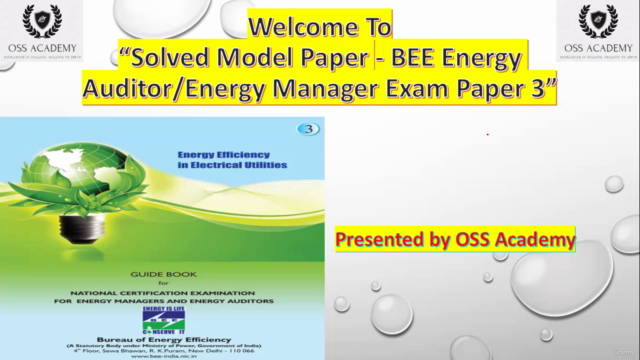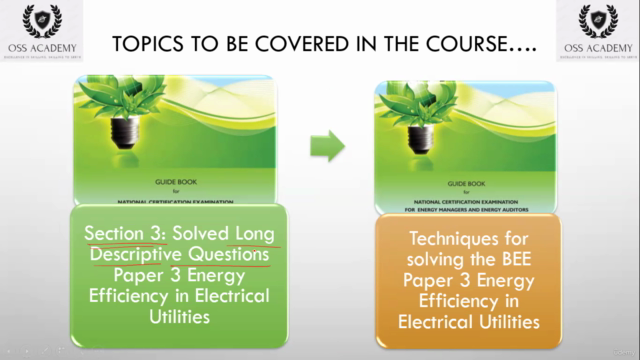Solved Paper: BEE Energy Auditor/Energy Manager Exam Paper 3

Why take this course?
-
Understanding Electric Motors:
Electric motors are devices that convert electrical energy into mechanical energy. They are the workhorses of industry, used to drive pumps, fans, conveyors, and machinery. The efficiency of electric motors is critical for overall energy savings in a plant or facility.
-
Types of Electric Motors:
- Induction motors (AC motors) are the most common type of motor used in industrial applications due to their reliability, simplicity, and cost-effectiveness.
- Synchronous motors are used where precise speed control is necessary.
- DC motors are used in applications that require variable speed or where a more controllable motor is needed.
-
Motor Characteristics:
- Efficiency: Motors are rated for efficiency, which indicates how much electrical power is converted into mechanical work. Higher efficiency motors use less electricity and generate less heat.
- Power (HP): The motor's capacity to perform work is measured in horsepower (HP).
- Speed (RPM): The rotational speed of the motor, usually given in revolutions per minute (RPM).
- Torque: The rotational force delivered by the motor.
- Service Factor: A measure of how much a motor can be overloaded without damaging it.
-
Motor Selection:
When selecting an electric motor, consider the following factors:
- Application requirements (load, speed, torque)
- Efficiency and power factor
- Service environment (temperature, humidity, vibration, etc.)
- Environmental impact and standards compliance (like IE3 or IE4 premium efficiency motors)
-
Energy Efficiency Improvements in EEMs:
Energy-efficient motor systems (EEMs) can reduce energy use by 20% or more. Improvements include:
- Upgrading to higher efficiency motors (IE3 and above)
- Implementing soft starters or variable speed drives (VSDs)
- Optimizing motor drive systems
- Regular maintenance and proper alignment
-
Factors Affecting Energy Efficiency & Minimizing Motor Losses in Operation:
- Core losses: Due to eddy currents and hysteresis in the motor's magnetic core.
- Copper (rotor and stator) losses: Caused by the resistance of the windings.
- Frictional and mechanical losses: From bearings, brushes (in DC motors), etc.
- Air gap losses: Due to the magnetic circuit incomplete iron path.
-
Motor Speed Control Systems:
Variable frequency drives (VFDs) or adjustable-speed drives (ASDs) are used to control motor speed and torque by varying the input frequency and voltage. This is more efficient than using mechanical devices like belts and pulleys.
-
Compressed Air System:
Compressed air systems are critical for many industrial processes. They consume significant amounts of energy, so optimizing their operation can lead to substantial savings.
-
Compressor Types:
- Reciprocating compressors are suitable for small to medium-sized operations.
- Centrifugal compressors are used for larger capacities and continuous duty applications.
-
Efficient Operation of Compressed Air Systems:
- Proper maintenance and regular checks
- Optimizing pressure settings
- Using air treatment devices efficiently
- Implementing demand-flow control systems
-
HVAC And Refrigeration System:
HVAC systems are essential for maintaining comfortable environments. Energy savings can be achieved through:
- High-efficiency cooling and heating equipment
- Proper insulation and building envelope optimization
- Energy recovery ventilators
- Smart thermostats and control systems
-
Energy Conservation in Buildings and ECBC:
The Energy Conservation Building Code (ECBC) sets minimum energy efficiency standards for buildings. Compliance with these codes can lead to significant energy savings. Technologies that contribute to energy conservation include:
- Advanced lighting control systems
- High-efficiency electrical equipment
- Automatic power factor controllers
- Energy management systems (EMS)
By implementing efficient motors, drives, and systems, and by adhering to codes like ECBC, we can significantly reduce energy consumption and operational costs. Regular maintenance, upgrades to more efficient technologies, and smart control systems are key to achieving these savings.
Course Gallery




Loading charts...